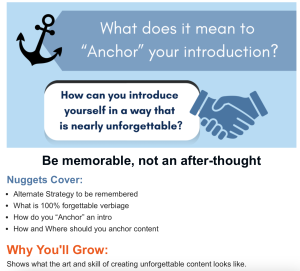Anchor In the Sale
$23.00
A must for every content creation and content strategy plan
Have you ever heard that you should sell your products and services by clearly displaying the features and benefits? Billions of dollars have been made this way. What if there was a better way? What if this nugget could prove to you that 95% of people forget a feature or benefit within 48 hours of reading it and that there is a way to display that same information making it THREE TIMES more memorable, sometimes even unforgettable?
This is a great nugget with many case studies. This nugget needs to be taught and shared far and wide.

A must for every content creation and content strategy plan
Have you ever heard that you should sell your products and services by clearly displaying the features and benefits? Billions of dollars have been made this way. What if there was a better way? What if this nugget could prove to you that 95% of people forget a feature or benefit within 48 hours of reading it and that there is a way to display that same information making it THREE TIMES more memorable, sometimes even unforgettable?
This is a great nugget with many case studies. This nugget needs to be taught and shared far and wide.
(0:00 – 0:19)
I was looking at my bookshelf and I remembered that my favorite book of all time, from a business standpoint, is Psychology of Selling. It’s a very subtle book that hits as hard as you can possibly hit business. And it’s subtle.
(0:19 – 0:45)
I mean, it is about the psychology of selling. I think it should be called The Psychology of Buying because the book is dedicated to why do people buy things? Brian says the definition of sales is a transference of feelings, meaning it’s got nothing to do with trial closes and value building statements and all the cliches of how to sell. It’s just simply a transference of feelings.
(0:45 – 0:52)
It’s a transference of conviction. It’s a transference of trust. It’s just truly an incredible book.
(0:52 – 1:18)
If you have not read it, I recommend you read it. And even though the actual material I’m going to talk about is not from Psychology of Selling itself, this is definitely Psychology of Selling, Psychology of Buying. Some of you know that we’ve had two different five-year spans, including the one we’re in right now, where we have doubled the previous year’s gross revenues five years in a row.
(1:18 – 1:22)
We’re now a two-time Inc. 5000 honoree. So pretty exciting stuff.
(1:22 – 1:41)
But I think a lot of that comes from the time I’ve spent with our sales team, our marketing team, and just teaching and educating the fundamentals of the Psychology of Selling. So I want to cover what I think are topics that you don’t simply hear about much. I don’t know if people don’t want to talk about them.
(1:42 – 1:52)
They don’t believe them. But I’m going to tell you what’s catapulting our growth, and you guys judge for yourself and maybe try these. If it works, rock and roll.
(1:53 – 2:03)
So here’s what I want everybody to do. If you’re driving in a car, just pretend. If you’re sitting at a desk, I want you to draw a circle with 10 little dots around it.
(2:03 – 2:11)
That circle represents the fact that you just walked into a wedding reception. You’re by yourself. You don’t have a spouse.
(2:11 – 2:22)
And nine other people showed up, some single, some married. But everybody came without their spouse. So five male, five female, just a mixed crowd, different ages, different areas.
(2:22 – 2:53)
Everybody, I want you to pretend everybody sits down at the exact same time, and they’re all complete strangers. So my question to everybody listening to this, what is the very first thing that’s going to happen when everybody sits down at the same time? Correct. Everybody’s going to make chit-chat, small talk, and quite frankly, it goes to the self-image of the people at the table.
(2:53 – 3:16)
So the lowest self-image typically goes first or last, but it basically goes like this, hey, how you doing? Oh, yeah, good, good. Yeah, where are you from? Oh, really? Yeah. You got any kids? Oh, what do you do? So, you know, bottom line is this, psychologists say that this is a seven to 10 step stair-stepping mechanism or method.
(3:17 – 4:15)
And watch this, the higher it goes, and the faster it goes, the faker it is. I don’t know if faker is a word, but the less real it is, meaning if you truly, if everybody truly sat down all at the exact same time, psychologists say that what’s actually going on in people’s mind when they sit at the table with strangers is they’re actually having a little bit of a sigh of relief because they go, oh, good, I don’t know so-and-so, I don’t have to make idle chit-chat, I’m still processing my morning or my afternoon, maybe your daughter, this was the case once in my case when I went to a wedding,-


